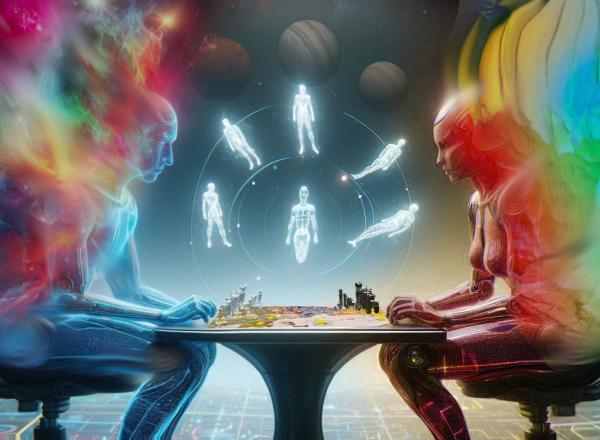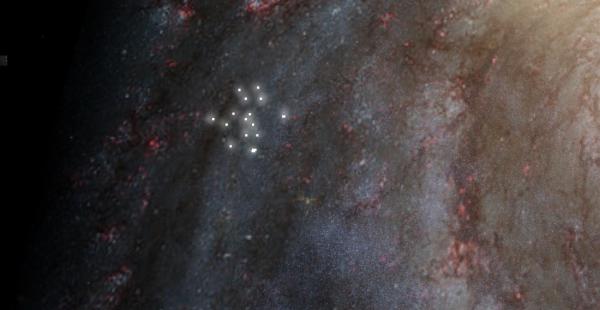BY LETTER
The Gods Ourselves
Galactography > Cybercosm, The
Culture and Society > Recreation > Games and Pastimes
Technology > Technology Type or Material > Virtual/Infotech
Sophonts > Modosophonts > Virtuals
Culture and Society > Recreation > Games and Pastimes
Technology > Technology Type or Material > Virtual/Infotech
Sophonts > Modosophonts > Virtuals
Popular Virch Roleplaying Game where the players take on the roles of 'Transaps' and 'Archai' |
 Image from Steve Bowers and Bing Image Creator |
The Gods Ourselves is a virtual reality roleplaying game, hosted by the Cyberian Network in their peristellar swarm around the star Almach, Gamma-1 Andromedae. Since 9398 this system has been running this virtual scenario at ten times external speed, so that players experience a hundred years for every ten years that passes outside. The scenario is based on the real Milky Way galaxy, with all the stars, worlds and resources simulated accurately; starting with transapients in the last years of the Old First Federation, this virch charts the emergence of the archailects and their rise to dominance.
Unlike many virtual scenarios of this kind, the archai are playable characters; in fact they are the only playable characters, and all modosophonts and lower transapient entities are simulated by the game AI systems. Each new player starts as an S1 transapient, and over time acquires new technology according to the overall development of the Terragen Civilisation, as well as through their own deliberate efforts and simulated toposophic advancement.
The Gods Ourselves is the largest, and longest running, virchworld in the so-called VirchGod genre, although scenarios of similar complexity are believed to exist in certain Panvirtuality cybercosmoi.
Although the game started quite slowly, as the Federation Megacorps at first resisted then embraced the new transapient empires, the action began to accelerate once the (simulated) transapients and archai acquired (simulated) wormhole technology and (simulated) reactionless drives. In the first few virtual centuries of the game, most players attempted to recreate the various historical empires, reproducing with some accuracy the various characteristics and predilections of the archailects concerned. Similarly the (simulated) population of each empire acted in character, accepting each empire's zeitgeist and worshipping the ersatz gods, with only a moderate and historically accurate amount of dissent, most of which was dealt with by the (equally simulated) lower transapient agents of the gods.
However the players gradually became aware that they had complete freedom of action within the constraints of the game; some started to extend their empires faster than the real examples (the Solar Dominion and Metasoft in particular); then some of the minor players began to attract simulated archai, including the Conver Ambi, the Penglai Empire and the Linn-Ent empire, which soon became Sephirotic Powers themselves. The rapidly-growing Terragen Sphere began to fill up with new factions, each ruled by an archai or group of archai with all the technology of Consolidation Age gods, but with practically none of their wisdom. The resulting Consolidation Wars were ferocious, disastrous for the virtual population of thousands of planets, and very badly planned from a strategic and tactical point of view. Although a number of lesser empires were defeated, often destroyed or subsumed by their neighbours, the vast majority of these lesser empires continued to exist, often sending out long independent filaments of colonisation into the surrounding galaxy, each with its own, extended wormhole tree. Many archai were assassinated in this period, the players concerned ejected from the game and forbidden to re-enter the scenario for ten (real-life) standard years.
An attempt at forming something like the Integration was largely a failure, although groups calling themselves the NoCoZo and the Solar Dominion (now the New Dominion) were formed as temporary alliances. Also at this time the number of stars encased in Dyson Swarms began to increase dramatically, faster, in fact than had been the case in the real universe. Megastructures of all kinds began to proliferate - not only in the MPA region (here known simply as Progress, and ruled by a large panoply of gods) but in every empire.
Around this time the first S:5 archailects began to emerge; vast entities anchored to a single star or network of nodes. Ascensions of this kind required vast amounts of in-game resources, and not all such ascensions were successful, so players were somewhat reluctant to attempt this move. Unsuccessful ascensions were rewarded with the player being removed from the game for a century (a thousand years in the game); some ascensions led to blights, which were seen as desirable roles to play by some of the more jaded players, but these inevitably led to defeat at the hands of the other participants. Players who successfully ascended to S:5 found themselves in charge of large empires which they could observe from either the (relative) safety of their brain-nodes or at close hand by sending out avatars.
With large numbers of Dyson swarms in the Civilised Galaxy it was not long before some of them were converted to weapons; Nicoll-Dyson Lasers, capable of destroying planets in other star systems. Periodically a player or several would use their N-DL systems to attack their neighbours; the light-speed delay between stars outside the various wormhole trees meant that these acts of aggression were often not observed until many years or even decades later. When such events did become known the perpetrators would generally become the target of many nearby systems, although a Dyson Swarm is a somewhat more difficult target than a single planet or bishop ring. The frequency of such events caused several of the archai empires to bind together into mutual defense alliances.
By the 45th century almost every player was anticipating a re-run of the Version War, although several groups attempted to prevent this from happening, saying that the conflict was not inevitable and could be avoided. Nevertheless the war started by almost unanimous agreement, a few decades early, even though very few of the players could explain what the conflict was supposed to be about. From the start it was much more ferocious than the real thing, with almost all of the empires in the Terragen Sphere taking part (even the Reformed and Provisional Utopia Spheres). Also involved were the numerous 'ahuman' empires, often headed by simulated archai who were played by aioid or non-human modosophonts. The many factions flung fleets of warships at each other, many of which were beaten off or destroyed by Nicoll-Dyson beams from the swarms and other giant megastructures that were more common in the sim than real-life. Even though a fleet of reactionless drive warships could easily evade the beams at a distance of several light minutes, as they drew closer the ships became easier targets. For this reason many of the actions occurred in deep space, or in those systems without swarms (which were still in the majority).
Very few of the combatants had any regard for the 'civilian' casualties that were the result of this conflict, so many worlds and systems were reduced to cinders; eventually the excitement wore off, and the combatants drew up new treaties, often agreeing to attack and destroy those few players who had not agreed to the ceasefire. Following the War there was a period of relative peace, which was referred to as the Commonwealth of Empires by those players who were history buffs; however the peace mostly consisted of political manoeuvres by the now-numerous S:5 players as they schemed and jockeyed for position while continuing to grab new territories in the Outer Volumes.
 Image from Steve Bowers | |
| The rash of artificial supernovae that occured during the (virtual) Verifex War | |
After several players ascended to S:6 (including new gods such as The Great Panjandrum, the God-Emperor Huangdi and Urizen, the Foretold), new technologies such as voidships and terrible metric weapons became available. As the Terragen Sphere expanded outwards new xenosophont empires were encountered; players who opted to represent these new factions were keen to assert themselves, so they quickly constructed infrastructure in the xenosophont home systems, ascending first to S:5 then to S:6 status (after some disastrous attempts leading to powerful local blights). The new Muuh Empire carved out a vast volume of the Perseus Arm, in collaboration with their occasional allies the Soft Ones (renamed the Peherperp Archempire). The xenosophont empires were fought to a standstill by players representing the Amalgamation, now allied with the Perseus Emperors and led by archai with S:6 status.
Many players have abandoned the game in recent centuries, claiming that the so-called greatest archai are too quick to use their most terrible weapons, such as Thunderbolts - a metric weapon that tears a rip through space-time. Other, newer players are more than ready to take their place.
Currently this virch game has moved past the notional 'present day' and is now depicting events four thousand years in the future; the Amalgamation and Perseus Emperors have been defeated by a coalition between the Muuh and the Meistersingers, while a To'ul'h archailect league has carved out a new domain in the Sagittarius Reach. Many of these factions are attempting to forge a new alliance to attack the aliens of MEEC 18, who claim to have the patronage of more distant xenosophonts with unknown capabilities.
Current factions include The New Progress, Conver Ultima, Empire of Heaven, Discordia, The Sth'th'h League, The Hypersaurian Empire, The Dominion of Stars, and MetaCosmos. Some players and conspiracy theorists believe that The Gods Ourselves is a testbed for godtech warfare techniques and may provide inspiration for new and eccentric strategies for combat in the future; others think that the real archailects require no such inspiration.
Related Articles
Appears in Topics
Development Notes
Text by Steve Bowers
Initially published on 29 February 2016.
minor canon updates by oa editors september 2023
Initially published on 29 February 2016.
minor canon updates by oa editors september 2023






